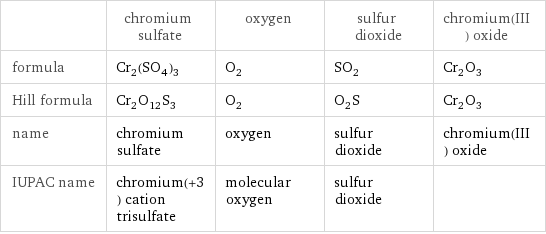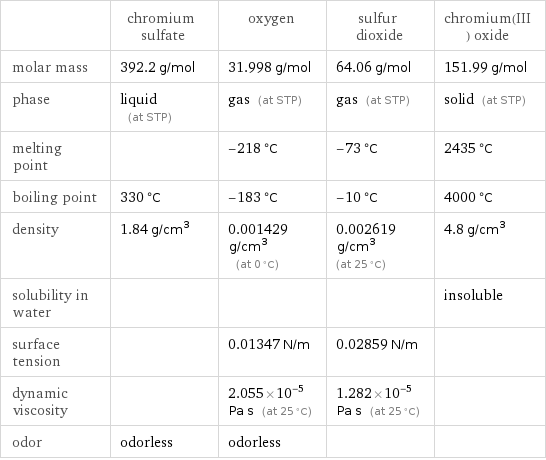Input interpretation

Cr_2(SO_4)_3 chromium sulfate ⟶ O_2 oxygen + SO_2 sulfur dioxide + Cr_2O_3 chromium(III) oxide
Balanced equation

Balance the chemical equation algebraically: Cr_2(SO_4)_3 ⟶ O_2 + SO_2 + Cr_2O_3 Add stoichiometric coefficients, c_i, to the reactants and products: c_1 Cr_2(SO_4)_3 ⟶ c_2 O_2 + c_3 SO_2 + c_4 Cr_2O_3 Set the number of atoms in the reactants equal to the number of atoms in the products for Cr, O and S: Cr: | 2 c_1 = 2 c_4 O: | 12 c_1 = 2 c_2 + 2 c_3 + 3 c_4 S: | 3 c_1 = c_3 Since the coefficients are relative quantities and underdetermined, choose a coefficient to set arbitrarily. To keep the coefficients small, the arbitrary value is ordinarily one. For instance, set c_1 = 1 and solve the system of equations for the remaining coefficients: c_1 = 1 c_2 = 3/2 c_3 = 3 c_4 = 1 Multiply by the least common denominator, 2, to eliminate fractional coefficients: c_1 = 2 c_2 = 3 c_3 = 6 c_4 = 2 Substitute the coefficients into the chemical reaction to obtain the balanced equation: Answer: | | 2 Cr_2(SO_4)_3 ⟶ 3 O_2 + 6 SO_2 + 2 Cr_2O_3
Structures

⟶ + +
Names

chromium sulfate ⟶ oxygen + sulfur dioxide + chromium(III) oxide
Equilibrium constant
![Construct the equilibrium constant, K, expression for: Cr_2(SO_4)_3 ⟶ O_2 + SO_2 + Cr_2O_3 Plan: • Balance the chemical equation. • Determine the stoichiometric numbers. • Assemble the activity expression for each chemical species. • Use the activity expressions to build the equilibrium constant expression. Write the balanced chemical equation: 2 Cr_2(SO_4)_3 ⟶ 3 O_2 + 6 SO_2 + 2 Cr_2O_3 Assign stoichiometric numbers, ν_i, using the stoichiometric coefficients, c_i, from the balanced chemical equation in the following manner: ν_i = -c_i for reactants and ν_i = c_i for products: chemical species | c_i | ν_i Cr_2(SO_4)_3 | 2 | -2 O_2 | 3 | 3 SO_2 | 6 | 6 Cr_2O_3 | 2 | 2 Assemble the activity expressions accounting for the state of matter and ν_i: chemical species | c_i | ν_i | activity expression Cr_2(SO_4)_3 | 2 | -2 | ([Cr2(SO4)3])^(-2) O_2 | 3 | 3 | ([O2])^3 SO_2 | 6 | 6 | ([SO2])^6 Cr_2O_3 | 2 | 2 | ([Cr2O3])^2 The equilibrium constant symbol in the concentration basis is: K_c Mulitply the activity expressions to arrive at the K_c expression: Answer: | | K_c = ([Cr2(SO4)3])^(-2) ([O2])^3 ([SO2])^6 ([Cr2O3])^2 = (([O2])^3 ([SO2])^6 ([Cr2O3])^2)/([Cr2(SO4)3])^2](../image_source/ba93e15b856b251b1bfb1307725d2794.png)
Construct the equilibrium constant, K, expression for: Cr_2(SO_4)_3 ⟶ O_2 + SO_2 + Cr_2O_3 Plan: • Balance the chemical equation. • Determine the stoichiometric numbers. • Assemble the activity expression for each chemical species. • Use the activity expressions to build the equilibrium constant expression. Write the balanced chemical equation: 2 Cr_2(SO_4)_3 ⟶ 3 O_2 + 6 SO_2 + 2 Cr_2O_3 Assign stoichiometric numbers, ν_i, using the stoichiometric coefficients, c_i, from the balanced chemical equation in the following manner: ν_i = -c_i for reactants and ν_i = c_i for products: chemical species | c_i | ν_i Cr_2(SO_4)_3 | 2 | -2 O_2 | 3 | 3 SO_2 | 6 | 6 Cr_2O_3 | 2 | 2 Assemble the activity expressions accounting for the state of matter and ν_i: chemical species | c_i | ν_i | activity expression Cr_2(SO_4)_3 | 2 | -2 | ([Cr2(SO4)3])^(-2) O_2 | 3 | 3 | ([O2])^3 SO_2 | 6 | 6 | ([SO2])^6 Cr_2O_3 | 2 | 2 | ([Cr2O3])^2 The equilibrium constant symbol in the concentration basis is: K_c Mulitply the activity expressions to arrive at the K_c expression: Answer: | | K_c = ([Cr2(SO4)3])^(-2) ([O2])^3 ([SO2])^6 ([Cr2O3])^2 = (([O2])^3 ([SO2])^6 ([Cr2O3])^2)/([Cr2(SO4)3])^2
Rate of reaction
![Construct the rate of reaction expression for: Cr_2(SO_4)_3 ⟶ O_2 + SO_2 + Cr_2O_3 Plan: • Balance the chemical equation. • Determine the stoichiometric numbers. • Assemble the rate term for each chemical species. • Write the rate of reaction expression. Write the balanced chemical equation: 2 Cr_2(SO_4)_3 ⟶ 3 O_2 + 6 SO_2 + 2 Cr_2O_3 Assign stoichiometric numbers, ν_i, using the stoichiometric coefficients, c_i, from the balanced chemical equation in the following manner: ν_i = -c_i for reactants and ν_i = c_i for products: chemical species | c_i | ν_i Cr_2(SO_4)_3 | 2 | -2 O_2 | 3 | 3 SO_2 | 6 | 6 Cr_2O_3 | 2 | 2 The rate term for each chemical species, B_i, is 1/ν_i(Δ[B_i])/(Δt) where [B_i] is the amount concentration and t is time: chemical species | c_i | ν_i | rate term Cr_2(SO_4)_3 | 2 | -2 | -1/2 (Δ[Cr2(SO4)3])/(Δt) O_2 | 3 | 3 | 1/3 (Δ[O2])/(Δt) SO_2 | 6 | 6 | 1/6 (Δ[SO2])/(Δt) Cr_2O_3 | 2 | 2 | 1/2 (Δ[Cr2O3])/(Δt) (for infinitesimal rate of change, replace Δ with d) Set the rate terms equal to each other to arrive at the rate expression: Answer: | | rate = -1/2 (Δ[Cr2(SO4)3])/(Δt) = 1/3 (Δ[O2])/(Δt) = 1/6 (Δ[SO2])/(Δt) = 1/2 (Δ[Cr2O3])/(Δt) (assuming constant volume and no accumulation of intermediates or side products)](../image_source/ecb68ba1b44d2c284cef9368c666da7e.png)
Construct the rate of reaction expression for: Cr_2(SO_4)_3 ⟶ O_2 + SO_2 + Cr_2O_3 Plan: • Balance the chemical equation. • Determine the stoichiometric numbers. • Assemble the rate term for each chemical species. • Write the rate of reaction expression. Write the balanced chemical equation: 2 Cr_2(SO_4)_3 ⟶ 3 O_2 + 6 SO_2 + 2 Cr_2O_3 Assign stoichiometric numbers, ν_i, using the stoichiometric coefficients, c_i, from the balanced chemical equation in the following manner: ν_i = -c_i for reactants and ν_i = c_i for products: chemical species | c_i | ν_i Cr_2(SO_4)_3 | 2 | -2 O_2 | 3 | 3 SO_2 | 6 | 6 Cr_2O_3 | 2 | 2 The rate term for each chemical species, B_i, is 1/ν_i(Δ[B_i])/(Δt) where [B_i] is the amount concentration and t is time: chemical species | c_i | ν_i | rate term Cr_2(SO_4)_3 | 2 | -2 | -1/2 (Δ[Cr2(SO4)3])/(Δt) O_2 | 3 | 3 | 1/3 (Δ[O2])/(Δt) SO_2 | 6 | 6 | 1/6 (Δ[SO2])/(Δt) Cr_2O_3 | 2 | 2 | 1/2 (Δ[Cr2O3])/(Δt) (for infinitesimal rate of change, replace Δ with d) Set the rate terms equal to each other to arrive at the rate expression: Answer: | | rate = -1/2 (Δ[Cr2(SO4)3])/(Δt) = 1/3 (Δ[O2])/(Δt) = 1/6 (Δ[SO2])/(Δt) = 1/2 (Δ[Cr2O3])/(Δt) (assuming constant volume and no accumulation of intermediates or side products)
Chemical names and formulas

| chromium sulfate | oxygen | sulfur dioxide | chromium(III) oxide formula | Cr_2(SO_4)_3 | O_2 | SO_2 | Cr_2O_3 Hill formula | Cr_2O_12S_3 | O_2 | O_2S | Cr_2O_3 name | chromium sulfate | oxygen | sulfur dioxide | chromium(III) oxide IUPAC name | chromium(+3) cation trisulfate | molecular oxygen | sulfur dioxide |
Substance properties

| chromium sulfate | oxygen | sulfur dioxide | chromium(III) oxide molar mass | 392.2 g/mol | 31.998 g/mol | 64.06 g/mol | 151.99 g/mol phase | liquid (at STP) | gas (at STP) | gas (at STP) | solid (at STP) melting point | | -218 °C | -73 °C | 2435 °C boiling point | 330 °C | -183 °C | -10 °C | 4000 °C density | 1.84 g/cm^3 | 0.001429 g/cm^3 (at 0 °C) | 0.002619 g/cm^3 (at 25 °C) | 4.8 g/cm^3 solubility in water | | | | insoluble surface tension | | 0.01347 N/m | 0.02859 N/m | dynamic viscosity | | 2.055×10^-5 Pa s (at 25 °C) | 1.282×10^-5 Pa s (at 25 °C) | odor | odorless | odorless | |
Units
